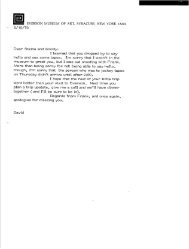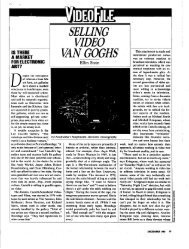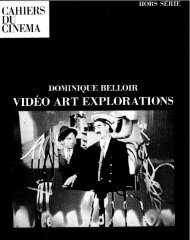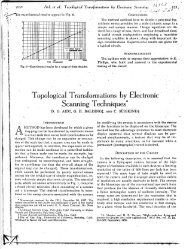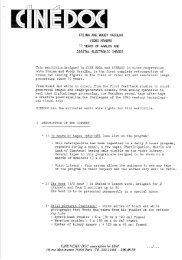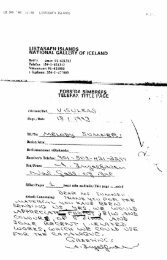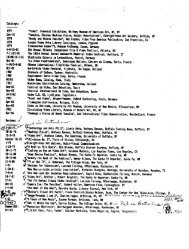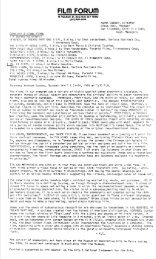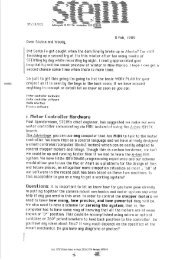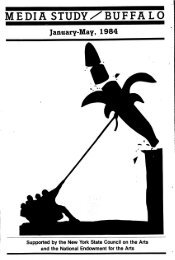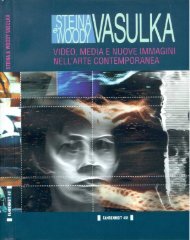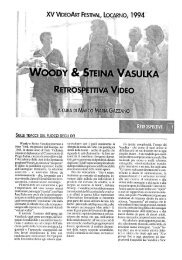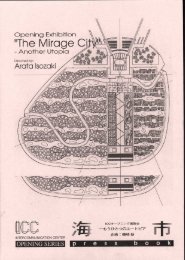Chapter 4: A HISTORY OF COMPUTER ANIMATION ... - Vasulka.org
Chapter 4: A HISTORY OF COMPUTER ANIMATION ... - Vasulka.org
Chapter 4: A HISTORY OF COMPUTER ANIMATION ... - Vasulka.org
Create successful ePaper yourself
Turn your PDF publications into a flip-book with our unique Google optimized e-Paper software.
<strong>Chapter</strong> 4: A <strong>HISTORY</strong> <strong>OF</strong> <strong>COMPUTER</strong> <strong>ANIMATION</strong> 3/20/92 8<br />
more efficient because the whole image is not redrawn each frame ;<br />
furthermore the image is more steady . In practice the cuttout need<br />
not be a free floating object, and may be attached to peg holes . It<br />
may also be articulated, a technique pioneered by Cohl and<br />
Armstrong (1910) . In Europe the cutout system remained the<br />
preferred method of production as late as the 1930s .<br />
Another strategy emerged at the Barre studio called the slash<br />
system, in which scenes were printed in mass on transcluent paper<br />
(1914) . The part of the field that contained changing action was<br />
"slashed out" with a rasor blade and the paper laid overtop a clean<br />
sheet, onto which the changing action was drawn . The pair of<br />
drawings was then shot together (fig . 16) .<br />
But more important still was the perfection by Earl Hurd of the<br />
cel process (1915) (fig . 17) . The cutout and the slash system<br />
reduced work because the entire scene was not redrawn every frame ;<br />
furthermore the line quality is more stable, since the unchanging<br />
lines were the same on each printed sheet . The cel system expands<br />
this concept by inking the drawing onto a registered transparent cel,<br />
opaquing it by painting the backside of the cel, and then layering this<br />
cel overtop of a single static background and photographing the<br />
stack . The cel process separates foreground and background art into<br />
work which gets drawn once and work which gets drawn every<br />
frame, and it allows the foreground cel to be translated relative to<br />
the background . This requires the invention of a compound table<br />
onto which the backgrounds and cels are placed for photography and<br />
illustrate this technology may be placing her into a technology<br />
which is before her time .)<br />
16 . The slash system (aka the slash and tear system) begins with<br />
identical drawings that have been printed onto paper and pegged .<br />
Whever action occurs the drawing is torn away (leaving a hole in the<br />
paper), laid over top a clean sheet of paper, and the area inside the<br />
hole is drawn in . This approach is the opposite of the cutout because<br />
the static action is laid on top of the changing element, rather than<br />
laying the changing element on top of the background . This setup is<br />
useful when the changing element wants to go behind things .<br />
17 . The cel system . The background is drawn onto paper and<br />
painted ; the foreground is drawn onto paper, then trace inked onto<br />
one or more flexible transparent cels, backside painted with opaque<br />
colors, then laid overtop the background and photographed . Action<br />
which is static is draw onto cels or backgrounds which are used for<br />
many frames, only the moving parts are transferred to cels which<br />
are different for each frame . [color example, plus process diagram] .



